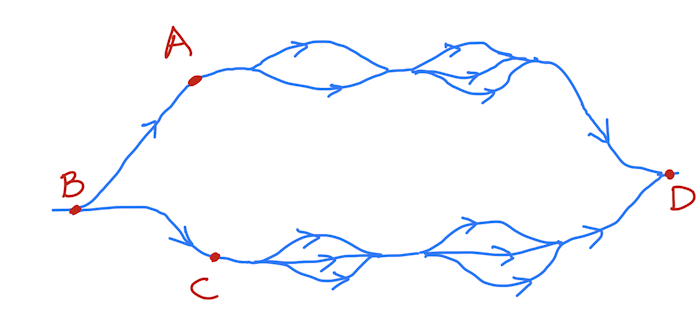Here are some specific activities, investigations or visual aids we have picked out. Click anywhere in the grey area to access the resource.
Here are some exam-style questions on this statement:
- "Consider the expansion of:" ... more
- "Nine cats squeeze through a gap in a fence to get to a fish pond. There is only enough room for one cat at a time to squeeze through the gap." ... more
- "A group of 12 children includes one pair of brothers, Andy and Archie, and one pair of sisters, Bally and Binda." ... more
- "A fund-raising activity involves people choosing three balls from a jar containing balls numbered 1 to 30. A prize of £5 is awarded if the three numbers chosen sum to a multiple of three. It costs £2 to have a go." ... more
- "Fifty years ago there was a zoo where animals were housed in cages. There were eight animal cages in a line on the northern perimeter of the zoo. Only four cages were being used: one to hold the gorilla, one for the chimpanzees, one for the gibbons and one for the macaques." ... more
Here is an Advanced Starter on this statement:
Click on a topic below for suggested lesson Starters, resources and activities from Transum.
Furthermore
The product principle states that if there are \(n\) different ways of performing an action, and for each of these there are \(p\) different ways of performing a second independent action, then there are \(np\) different ways of performing the two operations in succession.
The sum principle is a counting rule that tells us how many ways we can perform an action. If we have \(n\) different ways of performing an action OR \(p\) different ways of performing a different, mutually exclusive action, then the sum principle tells us that there are a total of \(n+p\) different ways we can perform the action.
For example:
How many ways are there of getting from A to D?
How many ways are there of getting from C to D?
How many ways are there of getting from B to D?

There are \(2 \times 3 = 6\) ways of getting from A to D (product principle).
There are \(3 \times 3 = 9\) ways of getting from C to D (product principle).
There are \(6 + 9 = 15\) ways of getting from B to D (sum principle).
Counting principles, including permutations and combinations, are fundamental concepts in combinatorics that are used to count the number of ways to choose or arrange objects in a set. Permutations and combinations are different ways of counting and are often used in probability problems.
Permutations:
$$\large{_{n}P_{r} = \frac{n!}{(n-r)!}}$$Where n is the number of objects in a set and r is the number of objects chosen. This formula calculates the number of ordered arrangements of r objects chosen from a set of n objects.
For example, suppose we have a set of 5 different letters: A, B, C, D, E. How many ways are there to arrange 3 of these letters?
We can use the permutation formula:
$$\large{_{5}P_{3} = \frac{5!}{(5-3)!} = \frac{5\times4\times3\times2\times1}{2\times1} = 60}$$Therefore, there are 60 different ways to arrange 3 letters from a set of 5 letters.
Combinations:
$$\large{{n \choose r} = \frac{n!}{r!(n-r)!}}$$Where n is the number of objects in a set and r is the number of objects chosen. This formula calculates the number of ways to choose r objects from a set of n objects, without regard to order.
For example, suppose we have a set of 5 different letters: A, B, C, D, E. How many ways are there to choose 3 of these letters?
We can use the combination formula:
$$\large{{5 \choose 3} = \frac{5!}{3!(5-3)!} = \frac{5\times4\times3\times2\times1}{3\times2\times1\times2\times1} = 10}$$Therefore, there are 10 different ways to choose 3 letters from a set of 5 letters.
The Binomial Theorem is a formula that allows us to expand expressions of the form $$(a+b)^n$$ where n is a positive integer. However, it can be extended to allow for fractional and negative indices, which can be useful in certain situations.
The Binomial Theorem for fractional and negative indices is given by:
\( (1 + x)^n = 1 + nx + \frac{n(n-1)}{2!}x^2 + \frac{n(n-1)(n-2)}{3!}x^3 + \cdots \)
This expansion is valid when \( |x| < 1 \) and \( n \) is any real number, including fractions and negatives.
Tip worth remembering
To find the binomial expansion of \( (2+x)^{ -\frac12} \) reduce the first term to one by taking out a factor of 2. It then becomes \( 2^{- \frac12} (1+ \frac{x}{2})^{-\frac12} \)
Then use the formula:
This is the formula to remember as it makes the working as easy as possible.
$$ 2^{-\frac12} \left(1+ \frac{x}{2} \right)^{-\frac12} = \dfrac{1}{\sqrt{2}} \left(1 - \dfrac{x}{4} + \dfrac{3x^2}{32} - \dfrac{5x^3}{128} + \cdots \right) $$How do you teach this topic? Do you have any tips or suggestions for other teachers? It is always useful to receive feedback and helps make these free resources even more useful for Maths teachers anywhere in the world. Click here to enter your comments.


